Fifty Years of an NFL Life

By Joe Browne
The Merger, in an Envelope
For years, I have modestly told friends that my role in the AFL-NFL merger cannot be overstated.
In the summer of 1966 I was working in the NFL office between my sophomore and junior years in college. While there had been months of rumors that the economic battle to sign players was going to result in either a merger, franchises folding in both leagues or some type of truce, no one in the media accurately predicted the news of June 8. Jim Kensil, who was Pete Rozelle’s talented right hand man in our small league headquarters, called me and my mailroom colleague Peter Hadhazy into his office that day. Behind closed doors, he gave each of us an envelope that already was addressed: one to the Associated Press sports desk at 50 Rockefeller Plaza and the other to the UPI sports desk at 220 East 42nd Street.
“Peter,” said Kensil, “you take this envelope to AP and call me from the lobby when you get there. Joe, you do the same when you get to UPI. We are announcing a merger with the AFL, and the press release with that news is in each envelope. It’s a big deal. I want to make sure both wire services receive it at the same time.”
Kensil gave each of us a quarter to make the calls back to him. Hadhazy and I didn’t take our mission quite as seriously as Kensil. On the elevator ride down, Peter asked if we should stop for a sandwich before we went our separate ways. I complained that I had to walk all the way to 42nd Street in the hot June sun while he would simply stroll across Rockefeller Plaza. We decided to have lunch after our mission was accomplished. That was probably a good decision since Kensil certainly would have fired us if we had stopped to eat.
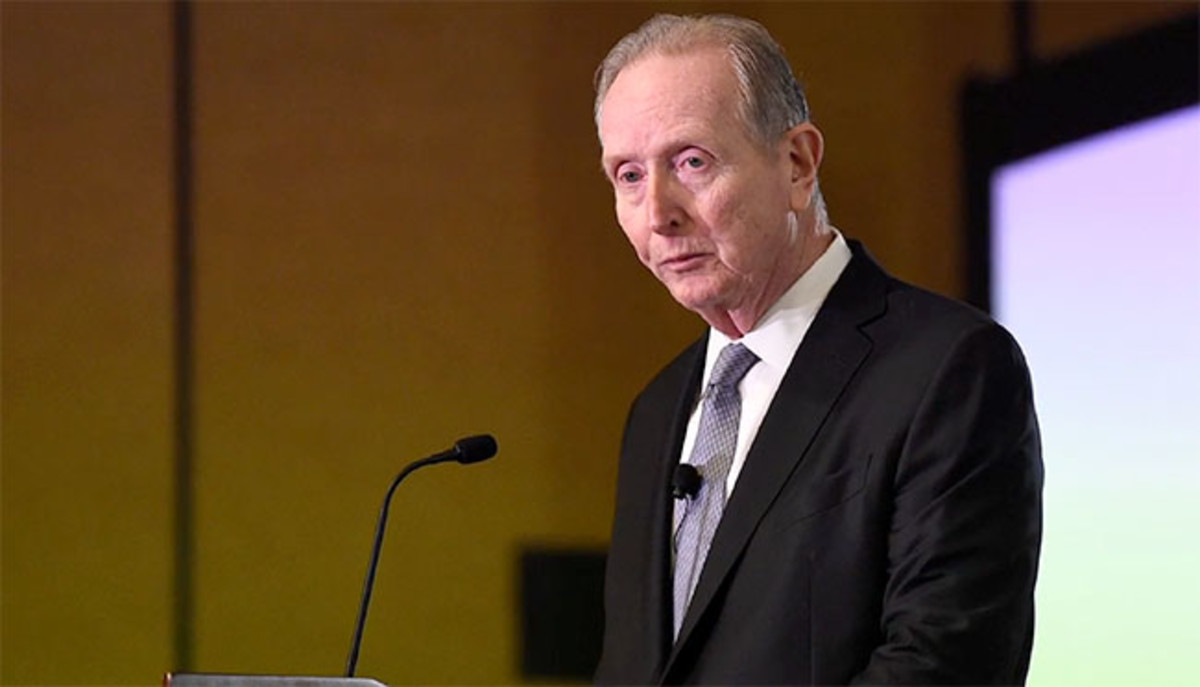
The news broke within minutes of us dropping the envelopes on the sports desks. The merger became not only the biggest sports story of the year but one of the major turning points in the future of our sport. However, I can’t help but wonder how the history of the league would have unfolded if Hadhazy (who later became Browns general manager) and I went to the beach that day.
* * *
The Very Bright Side of a Bad Super Bowl Loss
Some Super Bowls are more memorable than others. I have been fortunate to attend the last 49 straight. While I can’t recall a specific play from Super Bowl 24 or a particular story that preceded Super Bowl 38, one game I never need to be reminded of is Super Bowl III (or, as I call it: “The Joe Willie Super Bowl”). The Jets upset the Colts 16-7, and the realization that the young AFL teams might be at least competitive with the traditional NFL clubs set in.
Two other things I remember about that January week in 1969: I was on active duty with the Marines that month and away from the NFL. I had been told to report to Parris Island, where I was to receive further orders. As it turned out (I admit this only because the statute of limitations has expired), the government screwed up my military papers. Instead of being shipped to Camp Lejeune for Advanced Military Training, I received orders to report 30 days later to the Marine Corps Recruit Depot in San Diego. I had nearly a month’s leave, and my NFL colleagues were in Miami preparing for Super Bowl III. My office wired me a plane ticket, and I flew to Miami and spent the evening looking out at the ocean. The next day, Jim Kensil gave me $25 to buy some clothes because I arrived in Florida in my uniform.
Secondly, while my colleagues and I were having a post-game beer trying to figure out what the hey had just happened to our “can’t-lose” Colts, I recall Kensil taking a draw on his cigarette and saying, “This probably is the best thing that could have happened. We have to start playing the AFL teams in 1970, and this will help show they belong in the merged league.”
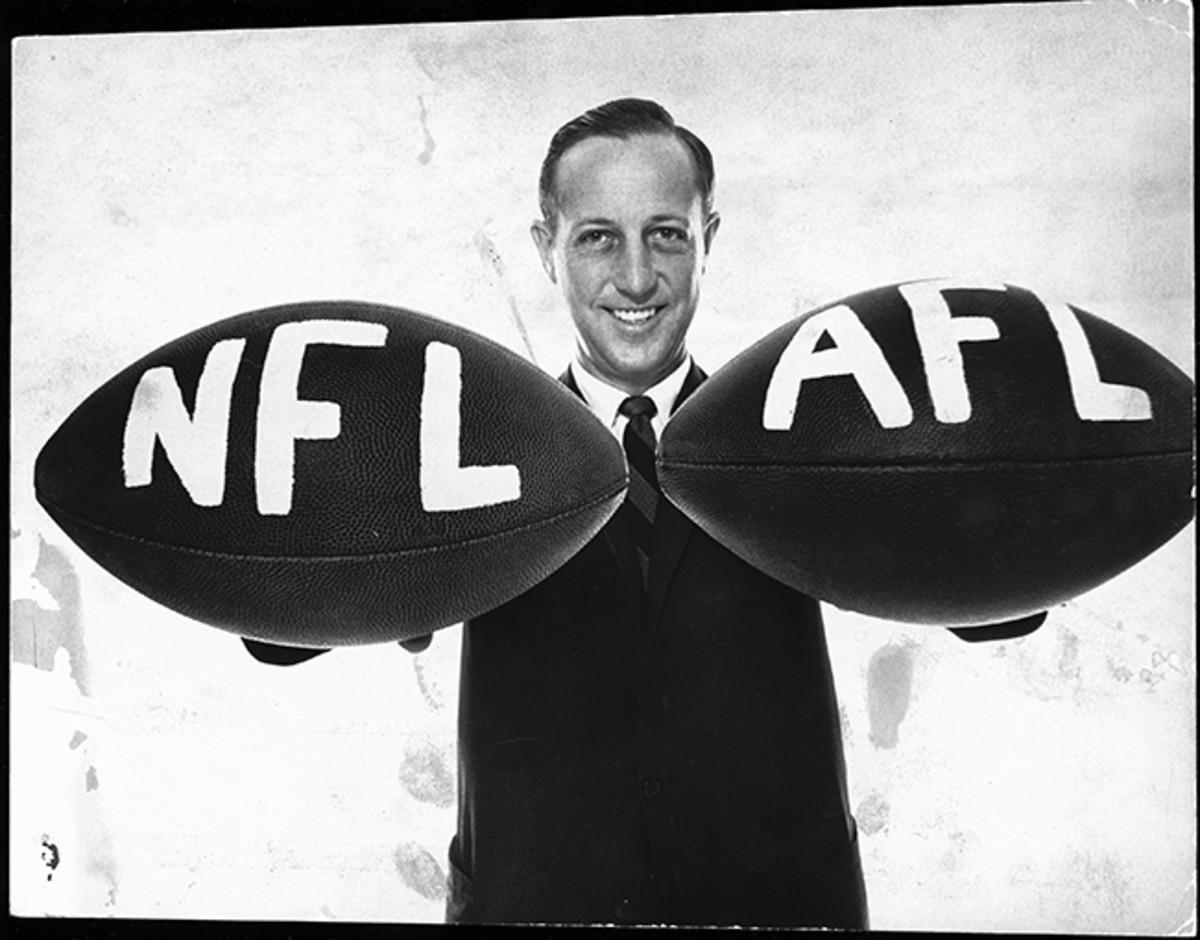
The exclamation point to this any-given-Sunday result: The AFL’s Chiefs defeated the NFL’s heavily favored Vikings in Super Bowl IV. By the time the two leagues merged, each had won two Super Bowls.
* * *
Goodell Walks In
Roger Goodell joined us in 1982 as a 23-year-old assistant in our public relations department. When our one-year commitment to him ended, he wisely took an internship that was offered by the Jets. He has often said it was the best thing he did because he was able to see the league from the perspective of a club. It also offered him the opportunity to work with coaches and other football people to learn the game. He soon realized how important each regular-season game was and how crucial each dropped pass or missed officiating call could be. After the Jets internship, we welcomed Roger back to our office; he was one of our few employees with club experience.
The biggest complaint I heard from club people over my NFL years was, “You guys on Park Avenue don’t understand what we in the real world at the club level go through.” Coincidentally, one of the first decisions Roger had to make after he became commissioner in 2006 was to decide whether to fine Steelers owner Dan Rooney, who had been the co-chair of the owners committee that had recommended Goodell for the job. We met regularly in those early days. and Roger asked me what I thought about a possible Rooney fine for his public criticism of game officials.
“I would let him go with a warning,“ I advised. “You hate to have one of your first major decisions be discipline against a respected team owner. Let it go, and let’s look at what else is on your plate.”
Roger didn’t like my advice. "The fact that other clubs will be looking is exactly why I should fine Dan,” he said. “I don’t want to show favoritism. The clubs will see right through that. What he said about the officiating was against our policy, and I don’t think it’s a question whether he should be fined but rather how much.”
End of discussion. The discipline was $25,000 and a stern rebuke from the new commissioner to one of his longtime mentors. I always will respect Roger for that. Not bad for an ex-Jets intern.
* * *
Tagliabue to the Rescue
The NFL received a challenge from the upstart USFL, which began play in the spring of 1982. While the USFL teams signed a few NFL vets, their real strategy was to build the league by giving big money to top draft choices such as Reggie White, Steve Young and Herschel Walker.
Having spent a large amount of player money, unwisely expanding from 12 to 18 teams in just one year and being pushed by New Jersey Generals owner Donald Trump to a fall season, the USFL sued us in federal court for $1.7 billion as a way of forcing a merger for at least some of the teams, particularly the Generals.
Pete Rozelle and the owners took the litigation seriously, always wise when the word “billion” is involved.
At our last league meeting before the start of the trial in 1986, former U.S. Attorney Robert Fiske, our lead trial attorney, updated the owners and tried to predict what the USFL’s legal strategy would be. Fiske was seated at the front table next to Rozelle. Norman Braman, the Eagles owner at the time, interrupted Fiske by asking: “Mr. Fiske, knowing what you know of the case, if the tables were reversed and you were the client and I was the attorney, would you settle or fight this case in court?”
Fiske hesitated for just a few seconds and shockingly said: “I would settle.”
When the owners realized what the lawyer who in a few short weeks would take them into a courtroom battle had said, the room went dead silent. I mean dead silent.
Suddenly, Paul Tagliabue, our chief outside counsel at the time, broke the silence from his head table position on the other side of Rozelle.
“Well, I wouldn’t,” Paul said, “and here’s why…”
He must have spoken for 10 minutes, barely pausing for a glass of water. The owners, who had been rocked by Fiske’s answer, were hanging on every word Paul spoke.
After Tagliabue’s monologue was completed, the commissioner adjourned the meeting for the remainder of the morning.
It was the most memorable moment of any league meeting I attended up to that time. I still get goose bumps recalling Fiske’s advice to settle.
Rozelle and his kitchen cabinet of owners immediately assembled in Pete’s suite to discuss what had just occurred. The end was result was that Frank Rothman, a skilled West Coast litigator, was brought East to take charge. Fiske, a real gentleman, moved over to the second chair. Months later, the USFL was awarded one dollar for their trouble and the NFL won every TV-related claim, the thrust of the case. The USFL never played another game.
I often wonder how the league’s future would have been shaped if Tagliabue did not rescue the 1986 league meeting moment. I believe that one incident stood out in the minds of many owners when they discussed a successor to Rozelle three years later.
* * *
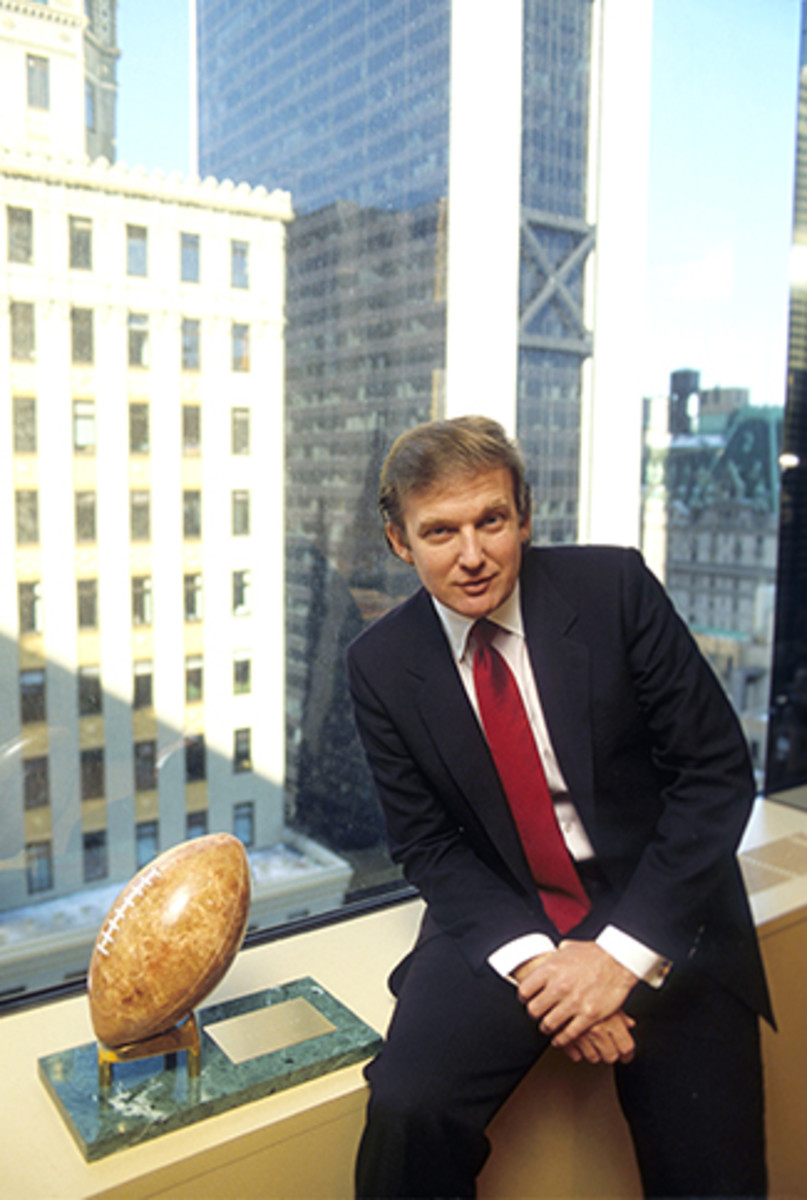
Rozelle vs. Trump
Pete Rozelle’s above-reproach reputation probably had more on the line during the USFL trial in 1986 than at any other time in his career. He testified for a period of 10 days both as a hostile witness called by the USFL to open the trial and then weeks later when we were presenting our defense.
He and USFL owner Donald Trump gave completely contradictory sworn testimony over what was said between the two at a crucial private hotel meeting in New York a year earlier.
USFL attorney Harvey Myerson, in his closing statement, all but accused Pete of lying under oath. I believed that one of them lied, but that it wasn’t Pete. He had written meticulous notes about the meeting as soon as he returned to the office that afternoon.
The jury deliberated for five days before telling Judge Peter Leisure that they had a verdict.
The courtroom was jammed when the jury returned and Trump, a Queens, N.Y., native like me, was standing in the back of the courtroom about 10 feet away from my position.
When the foreperson read the jury’s findings of $1 in damages, Donald raced out of the building faster than Herschel Walker. Pete and the NFL were vindicated. The jury found that the USFL’s problems were self-inflicted and that none of the eight television-related claims the USFL had pressed were valid.
After meeting with a crush of media on the courthouse steps, Pete and the attorneys agreed to reconvene back in our Park Avenue offices.
When I returned about 5 p.m., Pete was sitting behind his desk with a few lawyers and senior staff in his modest office. We had a champagne toast for the lawyers, but the real toast should have been directed to Pete. He had endured 10 grueling days of testimony and the wrath of front-page tabloid coverage all instigated by Trump and his allies. In his spare time, Pete was operating the largest sports league in the country.
There was no celebratory dinner at 21 Club or the Four Seasons that night. Instead, Pete left his office around 7 p.m., got into his customary front passenger seat of a Ford station wagon, and was driven back to his home in Westchester.
We had won the case, and Pete’s solid reputation, which was built over decades in pro sports, remained intact. I was pleased for him, and relieved that the jury saw through Trump’s “sworn” testimony.
* * *
When Rozelle Walked Away
Our office liked to steal headlines from other sports during our off-season, but the news that occurred on Wednesday, March 22, 1989, was so big that it knocked international items off the front page of most newspapers. That was the day Pete Rozelle resigned as NFL commissioner after nearly 30 years on the job.
The news broke when we were attending our annual league meeting in Rancho Mirage. The owners, club execs and most head coaches were in town, in addition to a large gathering of media. During the Tuesday lunch break, Rozelle sent word that he wanted me and two of my longtime colleagues—executive director Don Weiss and broadcasting guru Val Pinchbeck—to meet with him in a small conference room. We thought the subject was the afternoon meeting agenda. After a few minutes discussing rule proposals, Pete got serious and in a halting voice hit us with the bombshell. “I have decided to resign and plan to announce it this afternoon at the start of the session,” he managed to get out before lowering his head and getting very emotional. The three of us looked at each other and then turned to Pete. Finally, Pinchbeck broke the ice: “Pete, I am happy for you,” he said. I immediately jumped on that comment: “Screw you, Val. Speak for yourself,” I said while quickly pondering both the long-term future of the league as well as whether my two young sons would now enjoy community college while I looked for other work.
Pete’s sense of humor was still intact through the tears. He gathered himself and told us his reasons for leaving. He then quickly discussed the logistics of the announcement: “Don, make sure all the owners are in the room at the start, and please make certain we have security on the doors. Joe, get all the media in the press room, and I will go there right after I tell the owners and I will make a statement to…” He got emotional again and couldn’t finish his sentence. I said: “Oh yeah. You are going to do just great telling the media.” He looked at me and smiled. He thanked us for our years of service and got ready to break the news.
Over the years, folks have asked me whether I knew in advance that Pete was planning to step down. I truthfully answer “Yes” without saying I knew only minutes—not days—before he told the world. Some of my friends see through my response. They ask me what I was wearing that day in the desert hotel. I had on a white sweater with sailboats on the front. They rightfully pointed out that, if I knew Pete was going to turn the NFL world upside down, I definitely would not be wearing sailboats. Guilty as charged!
* * *
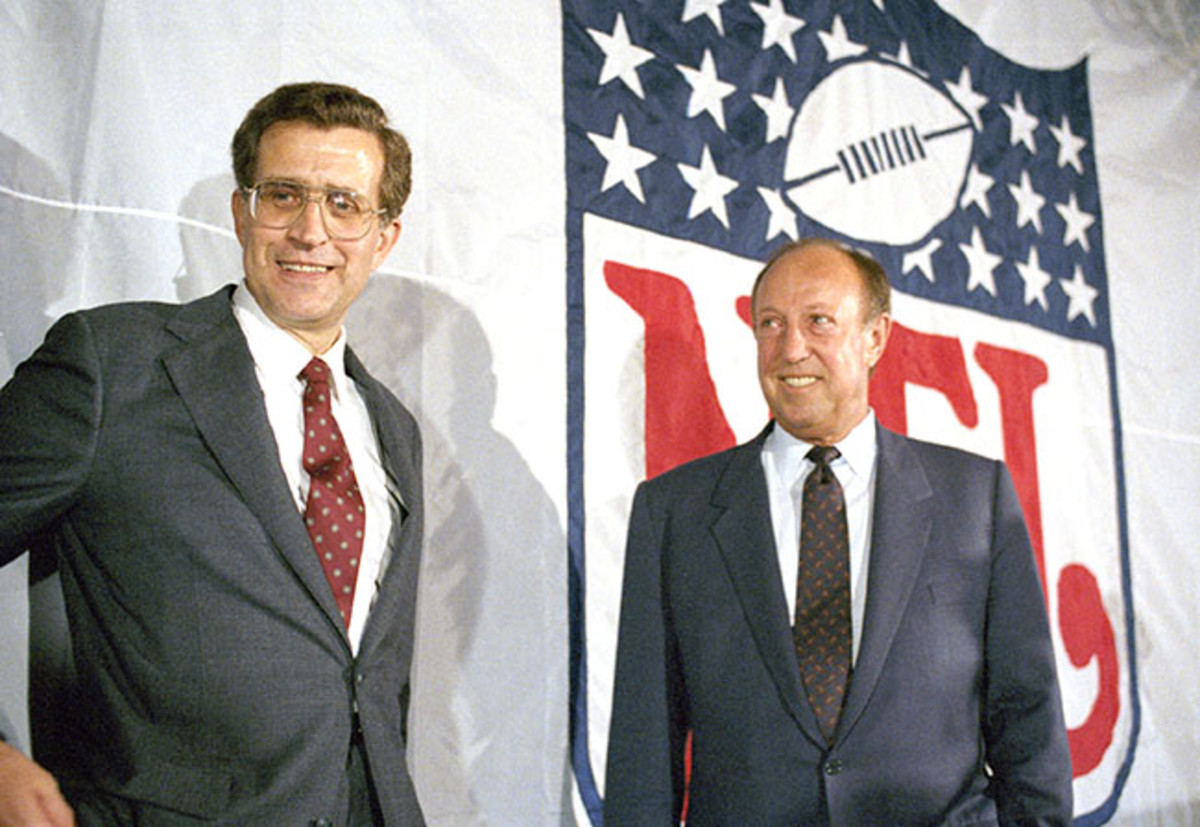
The Commissioner Search and the ‘Chicago 11’
When Pete Rozelle announced his retirement in 1989, nearly everyone’s name (and I mean nearly everyone’s name, including mine) was floated as his successor.
A search committee of owners was appointed to find the next commissioner. The so-called “old guard owners” were represented on the committee: Art Modell, Ralph Wilson, Dan Rooney and Well Mara. It became clear after several weeks that their nominee was veteran club exec and former NFL player Jim Finks. At that time he was president of the New Orleans Saints after stints with the Vikes and Bears. No doubt it would have capped Jim’s career, but one negative was that Jim, at 62, was only one year younger than the retiring Rozelle.
The first league meeting to vote on a new commissioner was in Chicago on July 6. All the media believed that Jim was going to be elected that day. Our office had reserved a suite for him under the alias Bill Barron, who worked in our West Coast office. I arrived at the hotel the night before and walked into the hotel restaurant with my colleague Jim Heffernan. As Heff and I walked by the lounge area, a number of owners and club presidents were in serious discussion over drinks.
We did not know it at the time, but that was the first meeting of the so-called “Chicago 11 Caucus” that would play a significant role in determining who would be elected commissioner. Fred Edelstein, who published a popular, gossipy weekly newsletter on the league, later joined us.
Sometime after midnight, we saw the group of owners disperse. We, too, were about to leave because the waiters were already setting the tables for breakfast. As I signed the bill, a worker came over and asked “Is either of you Mr. Browne? There’s a telephone call for you.” That’s never a good message when you are on the road and the hour is late.
I walked over to the phone (yes, millennials, during the pre-cell phone days), and I recognized the voice on the other end.
“Brownie, it’s Mike,” said Mike Lynn, the president of the Vikings and the first club executive to publicly announce Paul Tagliabue for commissioner weeks earlier.
“I don’t know how exactly you got involved in this,” he said, “but Tags told me, if I ever wanted to get him a message, it should go through you. Tell Paul not to listen to the chatter; Finks is not going to be elected tomorrow. We have the votes to block that move.”
That was big news considering early editions of the July 6 papers already had headlines to the effect “Finks to Be Voted NFL Commissioner Today.”
I waited until a reasonable hour the next morning and relayed the message to Tagliabue, who was in Washington. He expressed little emotion on the phone. He thanked me, and we agreed to talk later. Lynn was right. The newer owners, such as Norman Braman of the Eagles, Ken Behring of the Seahawks and Jerry Jones, were upset that the search committee had not expressed much interest in their views on the next commissioner. The movement to block Finks originated in that lounge in Chicago. The search continued through the summer months and into the fall. Finally, at a league meeting in Cleveland on October 26, the deadlock was broken, and Tagliabue was elected the league’s seventh CEO.
I have a picture from that day. I am flanked by the smiling, outgoing Rozelle and the new commish. I modestly captioned it: “The One Man Transition Team.”
* * *
‘The Al Davis Publicity Department’
Al Davis and Pete Rozelle had very few friendly words for each other during my career. I believe it stemmed in good part from the 1966 AFL-NFL merger when Al, the AFL commissioner, was kept in the dark while the secret merger talks were occurring among Tex Schramm, Rozelle and the AFL’s Lamar Hunt. By the terms of the merger, Rozelle was the named the commissioner of all pro football, and Al was out. He eventually moved back to the Raiders, where he had a Hall of Fame career.
Fast forward to 1993. Rozelle was living a quiet retired life in southern California, not far from Del Mar racetrack. Tagliabue and the owners’ labor committee had belatedly asked Davis to assist in getting a new CBA. The thinking was it was better to have Al inside the tent than having him second-guessing an eventual deal.
When a new landmark CBA was reached that year, Davis and I found ourselves as seatmates on a commercial flight to a league meeting where other owners were waiting to vote on the agreement. Al asked if I would make sure that he received some of the media credit for the new CBA.
The New York Times, in reporting the new deal, cited an anonymous league source as crediting Al for his role. However, the following day the Los Angeles Times was even more specific to the effect: “League spokesman Joe Browne said that Al Davis was among those owners who were very helpful in negating the new deal.”
As soon as I saw my name in print, I anticipated one call from southern California. A few hours later, my assistant said “Mr. Rozelle is on the phone.”
I picked up and said “Hello.”
The voice on the other end: “Is this the Al Davis publicity department?”
“I have been expecting your call, and the only thing that surprises me is that it took you this long,” I replied.
We both laughed, as we did many other times over that incident. Pete, at that point, was in retirement mode and couldn’t care less about Davis. He just wanted the league to succeed, and getting this CBA done was a major milestone.
I was as loyal a Rozelle guy as there was in the league. He hired me at 17 and wrote from his deathbed that I should be in charge of his memorial service in New York. I loved Pete… just like so many folks, whether they had worked for him or had just met him over the years.
* * *
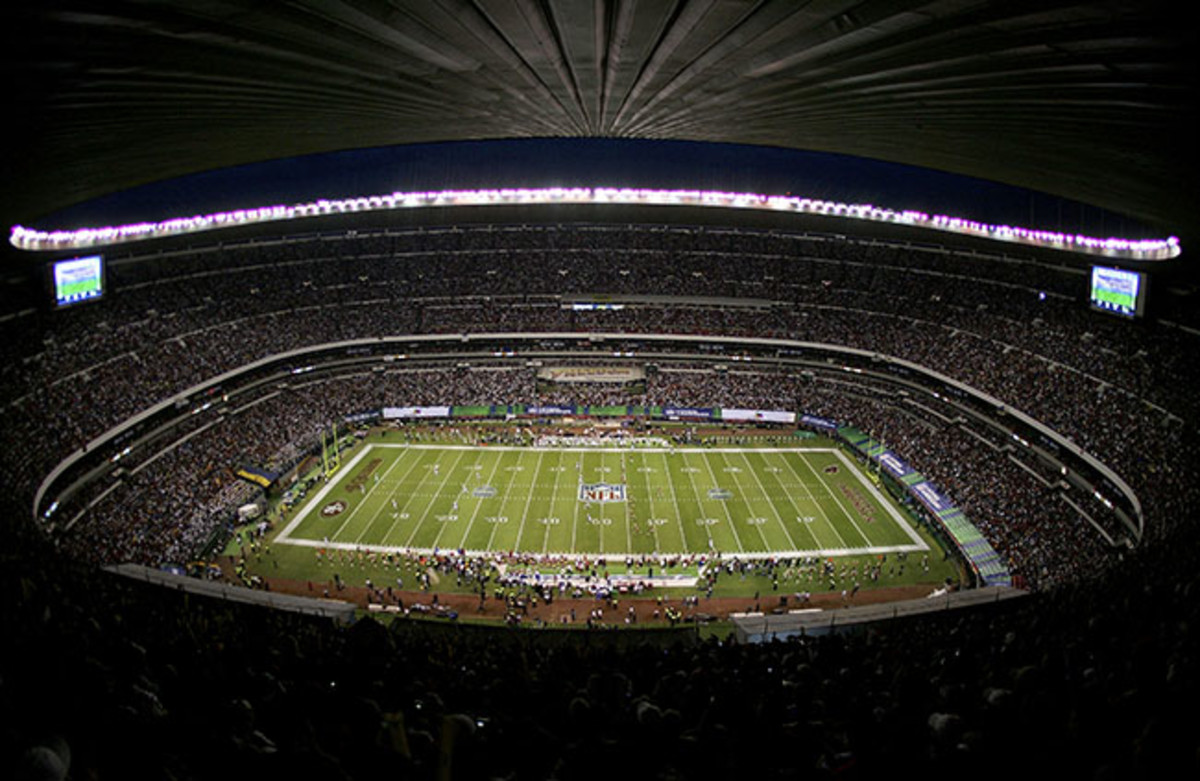
America’s Game Sets a Record in Mexico
Roger Goodell announced at the league meetings last month that we would play our second-ever regular-season game in Mexico City this fall.
Mexico is a hotbed for American football, which for years has received our game telecasts live each weekend. Colleges and universities have club teams whose games also are well attended. Speaking of attendance … we set a then-regular-season NFL record when 103,467 fans saw the Cardinals defeat the 49ers on October 2, 2005, at Azteca Stadium in our inaugural game in Mexico.
In the weeks leading up to that game, we knew that we would draw a huge crowd in a big soccer stadium. Both teams had done a terrific job promoting the game down there.
As someone who had been in the league 40 years in 2005, I personally found it odd that we possibly would set an attendance mark for America’s favorite sport outside our country. I was the communications chief back then and felt an institutional loyalty to our teams and the millions of American fans who had filled stadiums at games over the decades.
I discussed the subject briefly at a staff meeting the week before traveling to Mexico. It received as much time on the agenda as it took to move to the next item.
The game and the day-of-game activities were a huge success. The stands were jammed two hours before kickoff. The Azteca ticket manager came up to Commissioner Tagliabue’s booth in the second half before the attendance was announced. Those were the instructions he had received.
He said he was prepared to announce a crowd of 103,467.
I wouldn’t let go. I quickly realized that number surpassed the then NFL record of 102,368, which had been set during the Rams’ glory days in 1957. The record had stood for nearly 50 years.
“We had an agreement that we would not set a new mark here in Mexico,” I passionately said to Tags and Roger, who was second in command then. “It’s not fair to the clubs and our fans back in the States.”
“Not only did we not have an agreement,” Tagliabue calmly said, “but I thought that was another example of your New York humor when you brought it up a week ago. We are going to announce an accurate number.”
The ticket manager turned to me and said: “Mr. Browne, with all due respect, I estimate that our crowd today is closer to 110,000 but we only have 103,000 seats. I think every stadium employee has at least two of his kids ‘working as assistant’ who really are in the aisles watching the game. I did not count them. 103,000 is a fair but probably understated number.”
I raised the white flag and the record was announced.
I am certain those same great fans in Mexico City will be back in force this November 21 for the Monday night game between the Texans and Raiders. This time around, I will not be there.
• Question or comment? Email us at talkback@themmqb.com.
